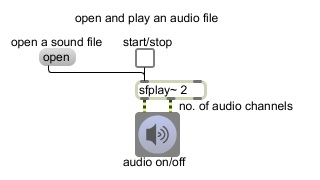This shows an extremely bare-bones program for audio file playback.
1. Click on the speaker button (ezdac~ object) to turn audio on.
2. Click on the word “open” (message object) to open a dialog box that allows you to select a sound file. (In the dialog, select a WAVE or AIFF file and click Open.)
3. Click on the toggle object to start and stop playing. (The toggle alternately sends a “1” or “0” to the sfplay~ object, which sfplay~ interprets as “start” and “stop”.)
The sfplay~ box is an MSP object. It performs an audio task: it plays sound files from disk and sends the audio signal out its outlets. The number 2 after sfplay~ is an ‘argument’, giving the object some additional information: that it should play in stereo, and thus should have two audio signal outlets. (The third outlet will send a notifying message when the soundfile is done playing, but this program doesn’t use that outlet.) The speaker button (a.k.a. the ezdac~ object) is a ‘user interface object’. It allows the user to interact with the program (in this case, by clicking on it with a mouse) and it performs a task (to turn audio on and off, and to play whatever audio signals it receives in its inlets as long as audio is turned on). Notice that the patch cords between the outlets of sfplay~ and ezdac~ are yellow and striped; that indicates that what is being passed between those objects is audio signal. The open object is a ‘message box’. It’s a user interface object, too. When clicked upon, it sends the message it contains (in this case, the word ‘open’) out the outlet to some other object. This is a message that sfplay~ understands. (If it were not, sfplay~ would print an error message in the Max window when it received an unfamiliar message.) The plain black patch cord indicates that what is passed between these objects is a single message that happens at a specific instant in time rather than an ongoing stream of audio data. The words ‘start/stop’ and ‘audio on/off’ are called comments. They don’t do anything. They’re just labels to give some information.
Here are a few thoughts for you to investigate on your own.
If you wanted audio to be turned on automatically when the patch is opened, and/or the ‘Open File’ dialog box to be opened automatically, how would you make that happen? (Hint: See loadbang.)
If you want to cause something to happen when the file is done playing, how would you do that? (Hint: Read about the right outlet of sfplay~.)
If you wanted to play the file at a different speed than the original, how would you do that? (Hint: Read about the right inlet of sfplay~.)
A single sfplay~ object can only play one sound file at a time, but it can actually access a choice of several preloaded sound files. How can you make it do that? (Hint: Read about the preload message to sfplay~.)
Suppose you’d like to be able just to pause sfplay~ and then have it resume playing from the spot where it left off rather than start from the beginning of the sound file again. Is that possible? (Hint: Read about the pause andresume messages to splay~.)
What if you want to start playback from the computer keyboard instead of with the mouse? (Hint: See key — and/or keyup — and select.)
Suppose you want to have control over the loudness of the file playback. What mathematical operation corresponds to amplification (gain control)? (Hint: See *~. See also gain~.)

